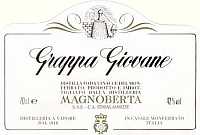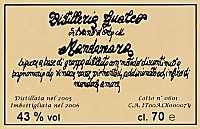
Wine Culture and Information since 2002 - Volume 22
 Wine Culture and Information since 2002 - Volume 22 |
|
Citrus FruitsPerfumed and delicious, citrus fruits are common in all the Mediterranean area, known and used for centuries both as a food and for the production of cosmetics |
|
Citrus fruits belong to the family of Rutaceae, subfamily Aurantioideae. The family of citrus fruits is made of three genuses: Citrus, Fortunella and Poncirus Trifoliata. Despite the genus of citrus fruits is made of three genders only and eighteen defined species, there are many natural mutations. For this reason citrus fruits are very common in the world, with which have also been created many hybrids. According to a botanical point of view, the fruit is a hesperidium, that is a berry with a pulp divided in segments containing seeds. The pulp of citrus fruits contain cellulose, whereas the juice contains carbohydrates, citric and tartaric acid, proteins, ashes, vitamin C, lipids, carotenoids and chlorophyll.
|
|
The homeland of the Citrus genus is China and India, Poncirus is from Korea and China, whereas Fortunella is from China. China and other neighboring regions are the territories from which citrus fruits have been originated, it is right in these regions we can find the first written evidences about citrus fruits. From the far east, citrus fruits begin to spread in the neighboring countries and arrive to India, Indochina and the islands of Southern Chinese Sea, the Philippines sea and the Indian ocean. From China citrus fruits also arrive to Japan: the modern satsuma mandarin, making 80% of this country's production, derives from Chinese guanxi. It seems this mandarin has been imported in Japan in 1500 and it quickly adapted to the new soil therefore becoming a typical product. The first written information about citrus fruits in India dates back to the times of the first written forms of Sanskrit, the Indo-European language imported from Aryans between 2000 and 1000 BC. In Sanskrit, citron and lemon are translated with the same word jambila: this term is found for the first time in the Vajasaneyi samhita, written around 800 BC. As in Sanskrit do not exist ancient words to refer to orange, this support the hypothesis it was imported in India from China about 2000 years ago, probably by the migrations from Yunnan to the Brahmaputra valley. It is known people from India had cultural and commercial contacts with the people of Mesopotamia, the land between the Tigris and Euphrates rivers. Despite the climate was not suited for the cultivation of citrus fruits, the skill of Mesopotamian agriculturists was successful in overcoming this limitation.
It is very likely the cultivation of citrus fruits made its way from India to Afghanistan and Pakistan, from here it spread in the west. Another evidence of the “migration” of citrus fruits to the west is offered by Jewish sacred books: the frequency with which the citron plant is mentioned suggests the Jews knew citrus fruits, or at least citron, before the Christian era. In Greece the citron plant is mentioned in many documents. In some papyri citron is mentioned with the word kitron, in other documents of the sixth century, such as the ones of Galen, it is used the term kitrion or kitreos. Theophrastus (372-287 BC) in his book “Historia plantarum”, describes the citron plant by specifying it was a plant common in Persia and in the land of Media. Another evidence is found in a book dated back to 200 AD, “Deipnosophistae” written by Athenaeus, in which it is said Juba, king of Mauritania, in his “History of Libya” mentioned this fruit and said it was called “Esperya apple” by Libyans. According to these evidences, it seems Greeks did not know any citrus fruits but citron, although the expedition of Alexander reached Punjab (India) and botanists also took part to the expeditions. Ancient Romans called citron malus medica first, then citrus. The first mention in Latin literature dates back to the second century BC by Cloanzio Vero, followed one century later by botanist Opium who mentioned it in its book “de Silvestris Arboribus”. Theocritus from Syracuse, who lived in the second century BC, did not mention it. In the Middle Age, during the first crusades, French saw for the first time citrus fruits and therefore introduced them in their homeland. Also the maritime republics contributed to the spreading of citrus fruits. In the twelfth, thirteenth and fourteenth centuries citrus fruits were common all over Italy, Spain and South France. It is believed sweet orange was not introduced in Europe by Arabs or by maritime republics: it probably were Portuguese to introduce it in the Old Continent. In fact, one of the first names used for sweet orange was “Portugal”. During Renaissance citrus fruits were spread and known everywhere: this is also proven by the many written documents, as well as being depicted in many paintings. In Italy the best climate for the cultivation of citrus fruits is in the south. In central and northern regions became common the custom of planting them in earthenware vases, which could be exposed to the sun during summertime and during wintertime moved in a place sheltered from the cold. This technique of cultivating citrus fruits also spread in France, and it was then adopted by Germans, Belgians and Dutch as well. At the end of 1700s citrus fruits were known in America too, introduced by Europeans during the colonization of the continent. As time passed by, new varieties of citrus fruits were discovered, including bergamot, grapefruit and Mediterranean mandarin, clementine and tangerine. In particular, bergamot was probably originated by a spontaneous hybridization, whereas grapefruit was discovered in the Barbados Island and was described in 1750 by Griffiths Hughes, whereas in 1789 Patrick Browne described the grapefruit discovered in Jamaica, and both them called it the “forbidden fruit”.
|
||||||||||||
|
The family of citrus fruits is vast and includes tens of varieties, many of them are used for nutritional purposes as well as in the cosmetic industry, others, which are not considered edible, are used by the cosmetic industry only because of their essential oils. Following is a list of the most important citrus fruits varieties, their use and properties.
Arabs discovered the extraction technique for essential oils, however the industrial production of perfumes with extracts of the skin of fruits and petals of flowers was invented by Italians. Naples and Sicily developed these techniques and from here started the fashion of exotic perfumes, which then spread all over Europe. According to a nutritional and dietetic point of view, citrus fruits have a fundamental importance in the diet of the Mediterranean area which is also the main area of production and consumption. In order to get the maximum benefits from citrus fruits juices, it is always advisable to consume them soon after their preparation, because vitamin C, when in contact with oxygen, light and heat, gets rapidly spoiled.
|
AquavitaeReview of Grappa, Distillates and Brandy |
|
|
| Distillates are rated according to DiWineTaste's evaluation method. Please see score legend in the "Wines of the Month" section. |

|
|
Grappa Giovane |
|
| Magnoberta (Piedmont, Italy) | |
| Raw matter: Pomace of Barbera, Freisa and Grignolino | |
| Price: € 13.50 - 70cl | Score: |
| This grappa is colorless, limpid and crystalline. The nose denotes intense, clean and pleasing of cherry, raspberry, plum and hazelnut with a slight perception of alcohol pungency. In the mouth has intense flavors with perceptible alcohol pungency which tends to dissolve rapidly, balanced sweetness, intense flavors, good roundness. The finish is persistent with flavors of apple and hazelnut. This grappa is produced with a discontinuous alembic still operating at low pressure. Alcohol 42%. | |

|
|
Grappa di Grignolino 1999 |
|
| Casa Luparia (Piedmont, Italy) | |
| Raw matter: Pomace of Grignolino | |
| Price: € 13.50 - 70cl | Score: |
| This grappa is colorless, limpid and crystalline. The nose reveals intense, clean, pleasing and refined aromas of cherry, raspberry, strawberry, cyclamen, rose and plum with almost imperceptible alcohol pungency. In the mouth has intense and pleasing flavors with perceptible alcohol pungency which tends to dissolve rapidly, balanced sweetness, agreeable. The finish is persistent with flavors of raspberry and strawberry. This grappa is produced with a discontinuous alembic still operating at low pressure. Alcohol 42%. | |

|
|
Grappa di Moscato Rosa 2004 |
|
| Zeni (Trentino, Italy) | |
| Raw matter: Pomace of Pink Muscat | |
| Price: € 25,00 - 70cl | Score: |
| This grappa is colorless, limpid and crystalline. The nose reveals intense, clean, pleasing and refined aromas of grape, rose, strawberry, cherry, raspberry and cyclamen with almost imperceptible alcohol pungency. In the mouth has intense and pleasing flavors with perceptible alcohol pungency which tends to dissolve rapidly, balanced sweetness, pleasing smoothness. The finish is persistent with flavors of strawberry, raspberry and grape. This grappa is distilled with a discontinuous bainmarie alembic still. Alcohol 40%. | |

|
|
Mandamara 2005 |
|
| Distilleria Gualco (Piedmont, Italy) | |
| Raw matter: Grappa of Dolcetto and Barbera, Bitter Almond | |
| Price: € 19.50 - 70cl | Score: |
| Mandamara shows a pale amber yellow color, limpid and crystalline. The nose denotes intense, clean, pleasing and refined aromas of bitter almond, honey, vanilla and plum with almost imperceptible alcohol pungency. In the mouth is sweet with intense flavor and perceptible alcohol pungency which tends to dissolve rapidly, pleasing roundness. The finish is persistent with flavors of almond and honey. Mandamara is produced by the maceration of bitter almond in grappa of Dolcetto and Barbera. Alcohol 43%. | |
Wine Parade |
|
|
| The best 15 wines according to DiWineTaste's readers. To express your best three wines send us an E-mail or fill in the form available at our WEB site. |
| Rank | Wine, Producer | |
|---|---|---|
| 1 |
| Brunello di Montalcino 1999, Castello Banfi (Italy) |
| 2 |
| Amarone della Valpolicella Classico 2000, Zenato (Italy) |
| 3 |
| Colli Orientali del Friuli Rosazzo Bianco Terre Alte 2002, Livio Felluga (Italy) |
| 4 |
| Wine Obsession 2001, Vignamaggio (Italy) |
| 5 |
| Notarpanaro 1999, Taurino (Italy) |
| 6 |
| Chianti Classico Riserva Novecento 2000, Dievole (Italy) |
| 7 |
| Trento Talento Brut Riserva Methius 1998, Dorigati (Italy) |
| 8 |
| Riesling Central Otago 2004, Felton Road (New Zealand) |
| 9 |
| Nero al Tondo 2001, Ruffino (Italy) |
| 10 |
| Chianti Classico Riserva Novecento 2000, Dievole (Italy) |
| 11 |
| Don Antonio 2003, Morgante (Italy) |
| 12 |
| Amarone della Valpolicella Classico 1998, Santa Sofia (Italy) |
| 13 |
| Amarone della Valpolicella Classico Costasera 2001, Masi (Italy) |
| 14 |
| Soave Classico Monte Alto 2004, Ca' Rugate (Italy) |
| 15 |
| Sagrantino di Montefalco Collepiano 2003, Arnaldo Caprai (Italy) |
|
||||||||
|
DiWineTaste Polls
|
| |||||||
Privacy Policy | |||||||


| Copyright © 2002-2024 Antonello Biancalana, DiWineTaste - All rights reserved |
| All rights reserved under international copyright conventions. No part of this publication and of this WEB site may be
reproduced or utilized in any form or by any means, electronic or mechanical, without permission in writing from DiWineTaste. |